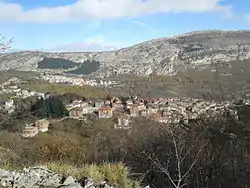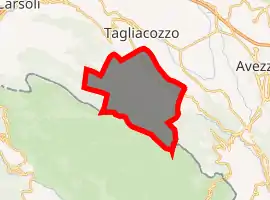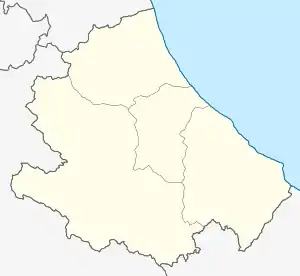Cappadocia, Abruzzo
Cappadocia ( In Marsican Dialect: Cappadoza[3])is a comune and town with approximately 550 inhabitants[4] in the province of L'Aquila in the Abruzzo region of central Italy. It is part of Marsica. It's also part of the "Borghi autentici d'Italia" (English: Autentic Boroughs of Italy) club
Cappadocia | |
|---|---|
| Comune di Cappadocia | |
 | |
Location of Cappadocia 
| |
 Cappadocia Location of Cappadocia in Italy  Cappadocia Cappadocia (Abruzzo) | |
| Coordinates: 42°00′27″N 13°16′51″E | |
| Country | Italy |
| Region | Abruzzo |
| Province | L'Aquila (AQ) |
| Frazioni | Camporotondo, Petrella Liri, Verrecchie |
| Government | |
| • Mayor | Lucilla Lilli |
| Area | |
| • Total | 67.20 km2 (25.95 sq mi) |
| Elevation | 1,108 m (3,635 ft) |
| Population (31 July 2015)[2] | |
| • Total | 529 |
| • Density | 7.9/km2 (20/sq mi) |
| Demonym(s) | Cappadociani |
| Time zone | UTC+1 (CET) |
| • Summer (DST) | UTC+2 (CEST) |
| Postal code | 67060 |
| Dialing code | 0863 |
| Patron saint | St. Blaise and St. Margaret |
| Saint day | 3 February |
| Website | Official website |
Physical Geography
The area, collected in the Valley of The Nerfa, between the south-ovest versant of the Caresolain Mountains (Padiglione and Aurunzo), and it marks the border between Abruzzo and Lazio, in the centre of the Appenino Centrale Abbruzzese.
It's 100 km to Rome[5] 135 km to Pescara,[5] 68 to L'Aquila[5] and 22 from Avezzano.[5] In the comune are included the frazione of Petrella Liri, Verrechie and the touristic destination of Camporotondo, collocated on the Cesca Mountains, and the Homonym ski station.
Etymology
There are various hypothesis on the name origin, and all are disputed[6]
▪︎ From the Latin Caput Duodecim, according to which, the town was founded by 12 criminals, who allegedly committed a "Rape of the Sabine Woman" at the near Petrella Liri
▪︎Again from Latin, Caput Otium, place where Shepherd went to relax.
▪︎ Or from the homonym Turkish Region.[7]
History
In ancient times, Aequi and Marsi lived in the region, before the Roman occupation, but there are nearly zero archeological testimonials from the area[8]
The first historical document, where Cappadocia is mentioned[8][9] is the Papal bull of 1158 of Pope Clement III, who nominates the Churches of Saint Blaise and Margaret the Virgin[10]
Later, it became part of the Albe county, and then of the Duchy of Tagliacozzo, both fiefs of the "Regno Di Napoli", until its annexion by Kingdom of Italy in 1860.
In the first year of the union, the Marsica, saw the impact of brigandage.[11][12]
Its inhabitants were mainly occupied by the Transhumance of the Ager Romanus[13] and by wood industry
The area, already damaged by the 1915 Avezzano earthquakes, experienced major human depopulation when many man were sent to war as Alpini guards.
Many, then started a mass immigration to the capital city, Rome.
References
- "Superficie di Comuni Province e Regioni italiane al 9 ottobre 2011". Istat. Retrieved 16 March 2019.
- "Popolazione Residente al 1° Gennaio 2018". Istat. Retrieved 16 March 2019.
- VV., AA. (1996). Dizionario di toponomastica. Storia e significato dei nomi geografici italiani. Milan: Garzianti. p. 136.
- demo.istat.it http://demo.istat.it/bilmens2019gen/query.php?lingua=ita&Rip=S4&Reg=R13&Pro=P066&Com=23&submit=Tavola. Retrieved 26 May 2020. Missing or empty
|title=(help) - Distance given by Google Maps
- Fiorillo, Alessandro. Storia di Cappadocia, Petrella Liri e Verrecchie, di Alessandro Fiorillo, Roma 2005 (seconda edizione in digitale del 2013).
- Even if there is a huge lack of elements to confirm this theory,it's notable to evidence that the Saint Patrons of Cappadoccia (Margaret the Virgin and Saint Blaise) are of Anatolic origin
- Fiorillo, Alessandro. Storia di Cappadocia, Petrella Liri e Verrecchie, di Alessandro Fiorillo, Roma 2005 (seconda edizione in digitale del 2013).
- "Comune di Cappadocia - Terre Marsicane :: Comune di Cappadocia". 2 June 2016. Archived from the original on 28 June 2016. Retrieved 26 May 2020.
- http://www2.regione.abruzzo.it/xCultura/asp/redirectApprofondimentiBC.asp?pdfDoc=xBeniCulturali/docs/beniculturali/Cappadocia.doc. Missing or empty
|title=(help) - Fiorillo, Alessandro (30 July 2015). "Cappadocia (AQ), tradizioni e natura: I briganti della Marsica, di Alessandro Fiorillo". Cappadocia (AQ), tradizioni e natura. Retrieved 26 May 2020.
- "Pereto (Aq) – Don Antonio Gagliardi". pereto.info. Retrieved 26 May 2020.
- Fiorillo, Alessandro. Storia di Cappadocia, Petrella Liri e Verrecchie, di Alessandro Fiorillo, Roma 2005 (seconda edizione in digitale del 2013).